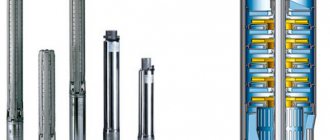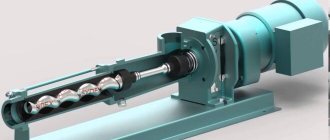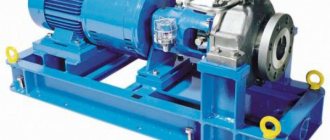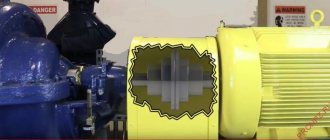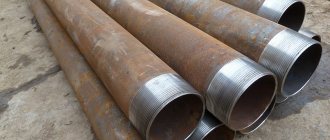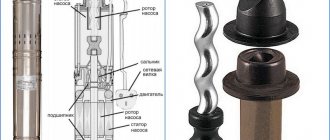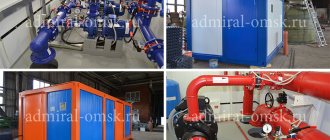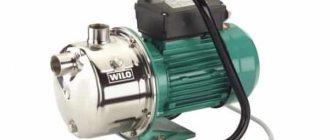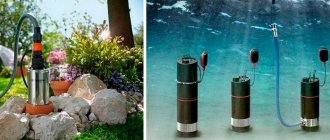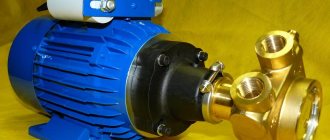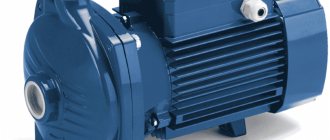Organization of water supply in a suburban or private area without centralized pipelines always comes down to the question of which pumps are better for a well: screw or centrifugal . The correct solution to the problem can be obtained in two ways: turn with full confidence to a professional consultant or independently study the features of their designs and advantages in use.
Main features of centrifugal pumps
The working body of centrifugal pumps is made in the form of a blade wheel with minimal clearances to the housing (water pumping chamber), which determines a number of operational features:
- Quite low operating noise and vibration, because During production, parts are not only precisely adjusted, but also balanced.
- High productivity with small size and electric drive power, and there are multi-stage modifications that allow pumping from great depths and to great heights.
- A large range of models with compact dimensions, as well as high reliability with a long service life.
At first glance, the pumps have excellent characteristics and the problem of which pumps are better for a well, screw or centrifugal , can be closed, but centrifugal units depend on the quality of the pumped liquid. Centrifugal force arises due to minimal gaps between the impeller and the casing, therefore, the entry of solid fractions into the flow leads to cavitation manifestations with intensive development of the working body and overload of the electric drive. For the same reason, starting “dry” or stopping the water supply leads to failure of the pump.
The best surface pumps
Marina CAM 80/PA
Technical characteristics of the surface pump:
- suction depth 8 m;
- head – 42 m;
- weight – 7.2 kg.
The Marina CAM 80/PA device operates silently and is additionally equipped with a water control sensor. Installation is carried out only in a horizontal position. The hole diameter is 1″.
The Marina CAM 80/PA pump produces stable pressure.
Note! Among users, it is often used to pump out initial water from a well with a high content of impurities.
Grundfos MQ3-35
The maximum head of the device is 33.8 m, the suction depth is no more than 8 m. The pump is installed horizontally and weighs about 13 kg. Equipped with a sensor that monitors the water level, protection against overheating, as well as an additional function for increasing pressure.
Most users are satisfied with this model, as it does not require maintenance for a long time and produces a constant and stable pressure.
The main disadvantages are the short cord, 2 m long, and the heavy weight. The device produces more noise than specified by the manufacturer. It is recommended for pumping only clean water, without impurities, otherwise the parts will wear out within one or two years, which leads to pump failure.
Gilex Jumbo
Model 70/50 Ch-24 is installed in a horizontal position. The maximum pressure is 45 m. The cord length is 1.5 m. The device is equipped with a 24 liter hydraulic tank and is fully automated. The body is made of cast iron and has small dimensions. Pressure adjustment possible. All parts and connections are made with high quality and without backlash.
The main disadvantage of the 70/50 Ch-24 Gilex Jumbo model is that the pump does not have protection against dry operation, and the cable is short.
Whirlwind PN-1100N
The centrifugal pump of this model is designed for installation in a horizontal position. The maximum pressure it produces is 50 m, the suction depth is 9 m. The engine runs quietly, the body is made of stainless steel and is light in weight. The pump is recommended for use with clean water only.
During operation of the pump, you need to ensure that it does not run dry, since the device is not equipped with a water control sensor.
Wilo PW-175EA
The maximum output pressure of this pump is 35 m with a suction depth of 8 m. Just like the previous model of the surface device, it is installed horizontally. The Wilo PW-175EA pump is equipped with overheating sensors and has compact dimensions. Power consumption 125 W. The device is assembled reliably and efficiently, and operates quietly.
The only drawback identified by users is that after a long period of inactivity, it may be necessary to push the impeller for the first start (with a screwdriver).
NeoClima GP 600/20 N
The pump can operate with a suction depth of up to 8 m. The maximum pressure it produces is 35 m. Power consumption is 600 W. The device is equipped with an overheating function. Equipped with a hydraulic tank with a volume of 20 liters. Recommended for pumping only clean water.
The pump body is made of stainless steel. The engine runs silently.
Note! Although the device is made in China, all parts are made and connected with high quality.
Judging by user reviews, the pressure switch may need to be adjusted, otherwise the pump will not turn off.
Main features of screw pumps
In screw pumps, the working body is presented in the form of a screw, which by rotation creates a turbulent flow of water, which determines the operational features:
- High productivity and water pressure, and multi-stage modifications practically remove restrictions on the depth of intake and the height of water rise.
- Low operating noise and vibration, and the production of unit parts is more uniform, because the resulting forces act in different directions.
- High operational reliability, so unit breakdowns are extremely rare, and the repair itself is not difficult and so expensive.
- Screw pumps are capable of pumping liquid with some contamination with solid particles, and their performance does not decrease, and the pulsation of the water flow is minimal, which allows the units to be used in wells and wells with low flow rates.
Considering these factors, the problem of which pumps are better for a well, screw or centrifugal , may seem to have been solved, but screw pumps are somewhat larger in size, which must be taken into account when selecting a unit for a well with a certain diameter.
The whole truth about the types of well pumps
This will be the shortest and most boring article on the site. An article about the types of pumps used for wells.
So, there are three types of pumps - submersible, surface
and those
that are out of order (sad joke).
Submersible
prefer to be in the well casing, directly in the water.
Surface
- suffer from aquaphobia, are located outside the well, water is sucked in using a bot (hose/pipe) lowered into the aquifer.
Submersible design
They are also divided into:
- vibration;
- screw;
- centrifugal;
- vortex.
*Left to right: surface, vibration, helical, centrifugal, vortex.
Superficial,
fortunately, almost all are centrifugal and slightly vortex.
So, let's go.
Surface pumps.
*Design of a typical surface pump.
The use of surface pumps for wells is limited to shallow depths
, from which he can lift water.
It's only 8 meters. More precisely not so. There are surface pumps that can reach depths of up to 50 meters (with injectors). But the reasonable price is only up to 8 meters, then the prices are “horror”, it is cheaper to use submersible pumps.
But if you have
an Abyssinian well
(narrow), then there is no alternative to a surface pump.
A surface pump needs some kind of shelter from precipitation (unless, of course, it is located in a caisson or in a house). The pump is noisy and becomes squealy over time.
, the author had it standing in a caisson and disrupting
the audio idyll
even at the far end of the 20-acre plot.
Requires water filling for initial start-up
.
If the check valve is slightly leaky
, then this manipulation may have to be done regularly. The author once, after a week-long absence from the dacha, had to pour birch sap into the pump - there was not a single gram of water in the house.
*On the left is a submersible pump, on the right is its advanced sister - a pumping station (pump + hydraulic accumulator + pressure switch).
Surface pumps are quite reliable
(both centrifugal and vortex) - personally, my cheapest pumping station worked
for about 7 years,
was sold along with the dacha and its further fate is unknown to me.
Indispensable for narrow Abyssinian wells
.
Submersible vibration pumps.
*Sectional view of a vibration pump.
These are pumps with the shortest lifespan
operation of all those considered.
Nevertheless, due to the lowest cost (three to four times cheaper than screw, vortex and five times cheaper than budget centrifugal ones)
they are quite common.
However, their use in wells is not recommended. The vibration created by such a pump can lead to silting and, accordingly, to the loss of the well.
The operating principle of a vibration pump is based on the use of an electromagnet, which, at the network frequency, draws in and pushes away an armature connected to a piston through a sealed membrane, which actually pushes out the water. The most short-lived parts of the pump subject to wear are the solenoid coil, check valve, piston, membrane, housing, and eyelets for attaching the cable. That is, almost everything that the pump consists of)))
.
Vibrating pumps can lift water up to 80 meters and have a maximum capacity of up to 1500 l/hour. The diving depth is usually limited to 7 meters.
Water intake can be top or bottom
. The upper one is slightly preferable - there is a greater chance that the coil will not burn out from overheating (if the water falls below the intake level, the pump itself will still cool).
*Vibration pumps with different types of water intake.
Due to unreliability, limited resource and risk of siltation, I do not recommend it
for use in year-round homes.
The maximum is a garden that is not frequently used, or a small amount of water for irrigation. Well, I repeat once again - using a vibration pump in a well is risky
.
Submersible screw pumps.
Screw pumps, unlike vibration pumps, have an electric motor. Water is pumped by rotating a screw (auger). In general, it’s a kind of electric meat grinder without knives.
*The design of the screw pump and the appearance of the auger.
Screw pumps are characterized by a high maximum water pressure, but low productivity.
A little more loyal
relate to the presence of impurities (sand) than all other types of pumps (for example, centrifugal up to 200 g/cub.m., screw - up to 1 kg/cub.m.).
The price is approximately one and a half times cheaper
than
budget centrifugal ones
.
But the reliability and service life
of these pumps is very short.
It’s true that repairs can (if the motor doesn’t burn out) be done at home and inexpensively.
The most vulnerable point of these pumps is the auger.
*A repair kit for a screw pump (auger) and a check valve (it’s better to replace it too) costs 1000 - 1500 rubles.
On some brands of screw pumps
(Whirlwind, Caliber, Host, Oasis, Vodotok, etc.) there are galvanized pins holding the upper and lower parts together, which rot in a couple of years.
I recommend purchasing these spare parts in advance and replacing them when repairing the auger.
*Stainless steel fasteners will cost 300 rubles, but the pump will not fall apart in the well.
My opinion - if you live in a private house with daily water consumption and do not want to change/repair the pump annually
— do not read
paid reviews about their reliability
on the Internet, and especially
do not buy screw pumps
.
There is no economic feasibility - a budget centrifugal pump will work at least three times longer
.
Moreover, if the well is deep enough, changing the pump is still a pleasure and
rarely does anyone want to do it often.
For a dacha without automation and filling the tank with water, this will work
, but only if
you are able to lift and change the pump yourself.
If you call specialized workers to raise/lower the pump, the screw pump will become “golden”. No wonder premium well pump brands don't have progressive cavity pumps
(Grundfos, Pedrollo, Wilo, etc.)
.
quite widely represented in retail stores , although not all brands produce them
.
Outwardly, they are similar to centrifugal ones, they are superior in price, and the design is usually not specified
.
I think that people, not knowing about such features, just look at the price tag
- that’s why they buy them.
PS There are four brands of pumps in our store. Quite decent and high quality. Aquarius, Aquatek, Belamos, Aquario.
But I’m talking about
centrifugal pumps
of these brands.
Aquatek, Belamos and Aquario also produce screw pumps. And this is the bottom.
After a short period of implementation, I
abandoned them.
But in principle, this can be said
about all screw pumps of any brand.
Submersible centrifugal pumps.
Today's best type of submersible pumps in terms of reliability and service life
.
The widest range and range of prices. More than 30
different brands in the Russian Federation.
Most centrifugal pumps use a classic layout
- in the upper part there is a block of impellers floating on the shaft (their number depends on the maximum lift height and productivity), in the middle there is a water intake, and at the bottom there is an electric motor block.
*Structurally, a centrifugal pump is more complex than a screw pump.
Household centrifugal pumps come in different diameters (from 50 to 110 mm), lift heights up to 200 meters, productivity from 1 to 10 cubic meters/hour.
Prices for centrifugal pumps (with identical characteristics) from budget and premium brands can differ by 3-4 times!!
Moreover, top pumps are usually sold with a short cable (1 - 2 meters).
However, in terms of durability and reliability, the difference is not significant
between the pumps
of the best budget
and
premium
brands (with the exception of the king of
Grundfos
, its reliability and durability almost correspond to the price)
.
However, if you decide to purchase a submersible centrifugal pump
Keep in mind that there are brands that produce
outright rubbish for decent money -
read “The best brands of centrifugal well pumps.” Review of budget brands."
Submersible vortex pumps.
This category of pumps is the rarest, however, it is worth saying a few words about it. Unlike centrifugal pumps, vortex pumps have only one, or maximum two, impellers. Well, their principles of action and forms are completely different.
*On the left is the impeller of a centrifugal pump, on the right is a vortex pump.
In terms of price, vortex pumps are slightly more expensive than screw pumps,
and in terms of service life and durability
they are much superior, but they are inferior to centrifugal ones in reliability
(but also cheaper)
.
But, we must take into account the marketing trick in the ears of manufacturers - if we take centrifugal and screw pumps of the same lift height, then
the cable of the latter will be much shorter
(a water-submersible cable is expensive).
Vortex pumps are the most demanding in terms of the presence of undissolved impurities in water - up to 50 g/cub.m.
. Well, also, it is structurally very difficult to make a vortex pump of small diameter, so as a rule they are 4 inches (not suitable for all wells).
Vortex, unlike screw, is produced by some premium brands
(Pedrollo, Calpeda).
A very good and economical option for gardening/irrigation if your well water is very clean
(without undissolved impurities).
Well, if you want to try to save a little on buying a pump, you can consider purchasing a submersible vortex pump for a residential building.
Read other articles:
“How to choose a hydraulic accumulator. Debunking myths and life hacks.”
“How to choose the right submersible pump for a well.”
“The best brands of centrifugal well pumps. Review of budget brands."
“The best brands of centrifugal well pumps. Premium."
Generalization and simplification of pump selection for a well
To choose the right pump, you need to consider several parameters:
- Well characteristics: water purity, well depth and flow rate, well bore diameter. The choice of pump depends on the combination of characteristics, because with low contamination, relatively shallow depths and sufficient flow rate, it is advisable to select centrifugal pumps, because their dimensions and electrical power are somewhat lower, which simplifies installation and saves money during operation.
- It is advisable to supply problem wells that have an unstable flow rate, a very low level of water intake, or an increased content of solid particles in the liquid with screw pumping units, because they are less problematic to operate and more reliable under harsh conditions.
Recommendations for selection
When choosing a pump, you should give preference to devices with a steel or cast iron body, as they are more durable. To prevent the device from breaking due to voltage surges in the electrical network, it is recommended to install surge protection. To prevent working elements from wearing out too quickly, filters should be installed.
To protect the pump from overheating and dry operation, it is better to install sensors if it is not equipped with them in advance. When calculating power, you should choose a device that is 20% more powerful so that it does not constantly work at maximum loads, as this will quickly lead to its breakdown.
